
Glutinous rice is a type of rice grown mainly in Southeast East Asia, the northeastern regions of India and Bhutan which has opaque grains, very low amylose content, and is especially sticky when cooked. It is widely consumed across Asia.

Indonesian cuisine is a collection of various regional culinary traditions that formed in the archipelagic nation of Indonesia. There are a wide variety of recipes and cuisines in part because Indonesia is composed of approximately 6,000 populated islands of the total 17,508 in the world's largest archipelago, with more than 1,300 ethnic groups.

Malay cuisine is the traditional food of the ethnic Malays of Southeast Asia, residing in modern-day Malaysia, Indonesia, Singapore, Brunei, Southern Thailand and the Philippines as well as Cocos Islands, Christmas Island, Sri Lanka and South Africa.

A rice cake may be any kind of food item made from rice that has been shaped, condensed, or otherwise combined into a single object. A wide variety of rice cakes exist in many different cultures in which rice is eaten. Common variations include cakes made with rice flour, those made from ground rice, and those made from whole grains of rice compressed together or combined with some other binding substance.

Peranakan cuisine or Nyonya cuisine comes from the Peranakans, descendants of early Chinese migrants who settled in Penang, Malacca, Singapore and Indonesia, inter-marrying with local Malays. In Baba Malay, a female Peranakan is known as a nonya, and a male Peranakan is known as a baba. The cuisine combines Chinese, Malay, Javanese, South Indian, and other influences.

Kue is an Indonesian bite-sized snack or dessert food. Kue is a fairly broad term in Indonesian to describe a wide variety of snacks including cakes, cookies, fritters, pies, scones, and patisserie. Kue are made from a variety of ingredients in various forms; some are steamed, fried or baked. They are popular snacks in Indonesia, which has the largest variety of kue. Because of the countries' historical colonial ties, Koeé (kue) is also popular in the Netherlands.
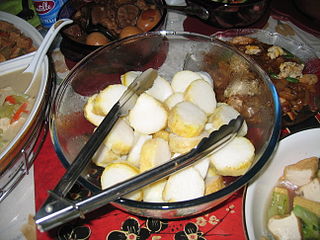
Lontong is an Indonesian dish made of compressed rice cake in the form of a cylinder wrapped inside a banana leaf, commonly found in Indonesia, Malaysia, and Singapore. Rice is rolled inside a banana leaf and boiled, then cut into small cakes as a staple food replacement for steamed rice. The texture is similar to that of ketupat, with the difference being that the ketupat container is made from woven janur fronds, while lontong uses banana leaf instead.

Javanese cuisine is the cuisine of Javanese people, a major ethnic group in Indonesia, more precisely the province of Central Java, Yogyakarta and East Java.
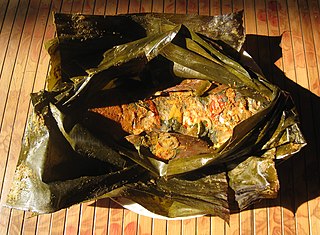
Pepes is an Indonesian cooking method using banana leaves as food wrappings. The banana-leaf package containing food is secured with lidi seumat and then steamed or grilled on charcoal. This cooking technique allows the rich spice mixture to be compressed against the main ingredients inside the individual banana-leaf package while being cooked and also adds a distinct aroma of cooked or burned banana leaves. Although being cooked simultaneously with food, the banana leaf is a non-edible material and is discarded after consuming the food.
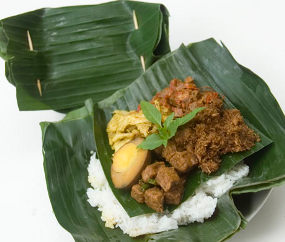
Nasi bogana or nasi begana, pronounced as nah-see boh-gâna, is an Indonesian-style rice dish, originally from Tegal, Central Java. It is usually wrapped in banana leaves and served with side dishes.

Sundanese cuisine is the cuisine of the Sundanese people of Western Java, and Banten, Indonesia. It is one of the most popular foods in Indonesia. Sundanese food is characterised by its freshness; the famous lalab eaten with sambal and also karedok demonstrate the Sundanese fondness for fresh raw vegetables. Unlike the rich and spicy taste, infused with coconut milk and curry of Minangkabau cuisine, the Sundanese cuisine displays the simple and clear taste; ranged from savoury salty, fresh sourness, mild sweetness, to hot and spicy.

Serundeng refers to a spicy grated coconut side dish or condiment originated in Indonesia that is used to accompany rice. Serundeng may taste sweet or hot and spicy, according to the recipe variants.
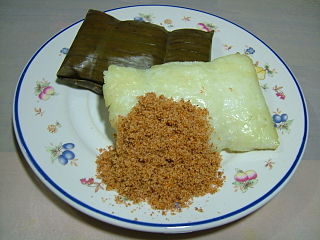
Burasa is an Indonesian rice dumpling, cooked with coconut milk packed inside a banana leaf pouch. It is similar to lontong, but with a richer flavour acquired from the coconut milk. It is a delicacy of the Bugis and Makassar people of South Sulawesi. It is also a dish associated with the Bugis diaspora, notably in the Malaysian states of Johor, Selangor, Sabah, and Sarawak where there are large established communities. It is often consumed as a staple to replace steamed rice or ketupat, and a popular accompaniment to a rich dish of chicken braised with galangal.
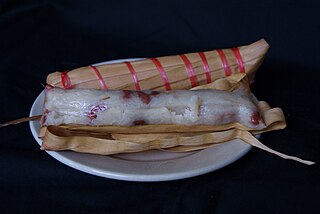
Lepet (Javanese), Leupeut (Sundanese), or Lepat (Indonesian) is a type of sticky rice dumpling mixed with peanuts cooked with coconut milk and packed inside a janur or palm leaf. It is a delicacy commonly found in Javanese and Sundanese cuisine, and often consumed as a snack. It is similar to lontong, but with a stickier texture and richer flavor due to the use of coconut milk and peanuts.

Betawi cuisine is rich, diverse and eclectic, in part because the Betawi people that create them were composed from numbers of regional immigrants that came from various places in the Indonesian archipelago, as well as Chinese, Indian, Arab, and European traders, visitors and immigrants that were attracted to the port city of Batavia since centuries ago.

Arem-arem is an Indonesian-Javanese compressed rice cake in the form of a cylinder wrapped inside a banana leaf, filled with diced vegetables, tempeh, or oncom, and eaten as a snack. It is sometimes also filled with minced meat or abon. Arem-arem is often described as a smaller size lontong with fillings, so it is sometimes also called lontong isi.
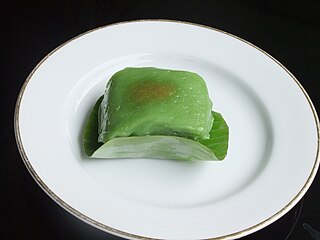
Kue bugis is Indonesian kue or traditional snack of soft glutinous rice flour cake, filled with sweet grated coconut. The name is suggested to be related to Bugis ethnic group of South Sulawesi as their traditional delicacy, and it is originated from Makassar. In Java the almost identical kue is called kue mendut or Koci Koci. Kue bugis, together with kue lapis and nagasari are among popular kue or Indonesian traditional sweet snacks, commonly found in Indonesian traditional marketplace as jajan pasar.

Lumpia are various types of spring rolls from China, Indonesia, and the Philippines. Lumpias are made of thin paper-like or crepe-like pastry skin called "lumpia wrapper" enveloping savory or sweet fillings. It is often served as an appetizer or snack, and might be served deep-fried or fresh (unfried). Lumpia are Indonesian and Filipino adaptations of the Fujianese rùnbǐng and Teochew popiah, usually consumed during Qingming Festival.
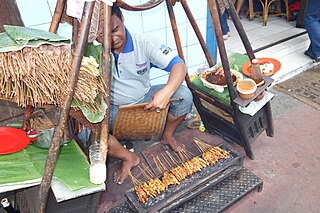
Madurese cuisine is the culinary tradition of the Madurese people from Madura Island in Indonesia. This cuisine is particularly well-known in the neighboring areas of East Java, as well as on the south coast of Kalimantan. As a leading salt production center in the Indonesian archipelago, Madurese dishes are often saltier compared to Eastern Javanese cuisine, although with significant Javanese influences.




















